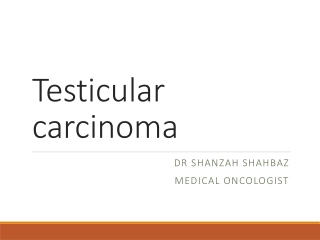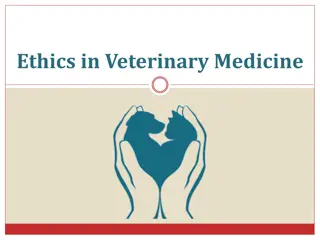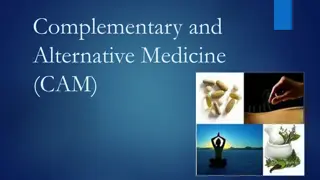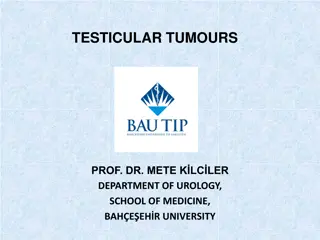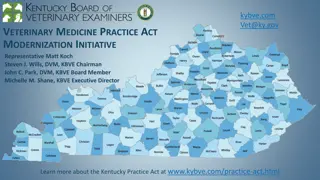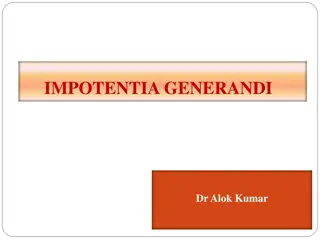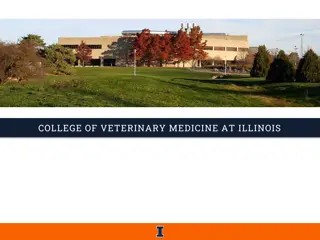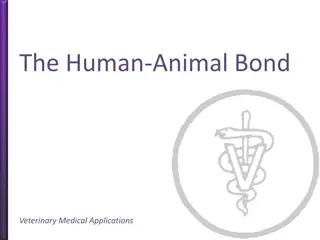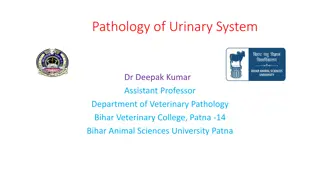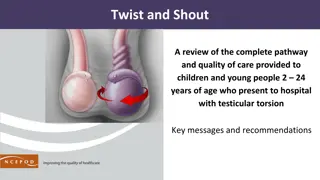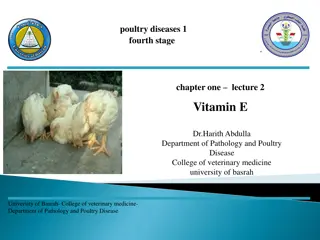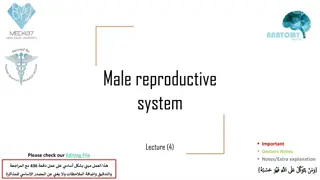Understanding Testicular Hypoplasia and Degeneration in Veterinary Medicine
Testicular hypoplasia and degeneration are conditions affecting the development and function of the testes in animals, particularly bulls. Hereditary and non-hereditary forms exist, leading to partial or complete failure in spermatogenic epithelium development. The incidence is low and sporadic, more common in bulls and boars. Symptoms include lower conception rates, firmer testes, and smaller scrotum size. Treatment involves understanding the underlying genetic and developmental causes.
Download Presentation

Please find below an Image/Link to download the presentation.
The content on the website is provided AS IS for your information and personal use only. It may not be sold, licensed, or shared on other websites without obtaining consent from the author. Download presentation by click this link. If you encounter any issues during the download, it is possible that the publisher has removed the file from their server.
E N D
Presentation Transcript
Testicular Hypoplasia and Testicular Degeneration Prepared by- Dr. S. K. Sheetal Assistant Professor cum Jr. Scientist Department of Veterinary Gynaecology and Obstetrics, Bihar Veterinary College, Bihar Animal Sciences University, Patna-800014 1
Testicular hypoplasia Congenital failure in the development of the spermatogenic epithelium while the intersititial tissue or Leydig cells are developed normally. It is found in two forms: hereditary and non- hereditary. In bulls incidence = 23% of testicular pathology cases.
Hereditary testicular hypoplasia: caused by a single recessive autosomal gene with incomplete penetration. Non-hereditary testicular hypoplasia: It is due to one or more extra X chromosome (e.g. XXY). Chromosomal testicular hypoplasia complete sterility disturbed meiosis.
Unilateral or bilateral The degree of hypoplasia partial to complete. In bilateral complete hypoplasia the animals are sterile. The affected testis is reduced in size depending on the degree of hypoplasia. The development of other genital organ is normal, sexual desire is not affected.
Incidence Incidence is low and condition is sporadic. common in bulls and boars and is infrequent in rams, stallions, dogs and cats. Unilateral testicular hypoplasia more common In bulls, left sided hypoplasia (66.7) is more than the right sided.
Etiology caused by a single recessive autosomal gene with incomplete penetration. Partial or complete failure of germinal cells to develop in the yolk sac during fetal life. Failure of migration of germinal cells from yolk sac to gonadal ridge during fetal life. Failure of multiplication of germinal cells in gonad during embryogenesis. Degeneration of embryonic germinal cells
Symptoms Lower conception rates in bilaterally affected males. The affected testes are usually firmer than normal. The scrotum of the affected male is smaller than normal male. The spermatic cords of hypoplastic testicles are shorter. A striking feature in partial hypoplasia is an increased incidence of proximal protoplasmic droplets in spermatozoa. An increased frequency of abnormal sperm head Sexual desire: excellent and coitus is prompt because Leydig cells remain unaffected.
Semen picture Unilateral or partial Low concentration Low motility High incidence of proximal protoplasmic droplets Presence of giant cells(multi-nucleated cells with 6-8 nuclei) and medusa cells (ciliated cells) Giant cells incomplete maturation division of Primary Spermatocytes Bilateral and complete Clear and watery Contain few or no sperm.
Diagnosis Size of scrotum: below the acceptable limit for the species and breed suspected testicular hypoplasia Size of testis: small and flabby but regular in outline and freely movable in the scrotum Size of epididymis: small and hard Libido Normal Semen picture: Giant & Medusa cells, low concentration of sperm and motility
The diagnosis of testicular hypoplasia should not be done before two years of age in the bull & horse Before one year of age in the boar, ram, dog and cat unless the male is well grown
Prognosis: Poor Treatment: Affected animal should not be used for breeding purpose because the condition is hereditary.
Difference between hypoplastic testicles and atrophic testicles Hypoplastic testicles Atrophic testicles Testes are firm Testes are sclerotic Freely movable Adhesions are in the scrotum frequently present.
Degeneration = deterioration of a tissue or an organ in which its function is diminished or its structure is impaired. Definition: partial or complete failure of epithelium of seminiferous tubules to proceed with spermatogenesis. It is an acquired disorder and is most common cause of infertility in male domestic animals. Small testicular size and abnormal function. May develop very rapidly within hours or few days but its regeneration takes very long time (over weeks or months).
Testicular Cells and Degeneration The seminiferous tubules of the testis are highly susceptible to damage from a wide variety of agents Differentiating germinal cells like primary spermatocytes, secondary spermatocytes and round spermatids are most susceptible to degeneration. Spermatogonia & Sertoli cells are the most resistant Therefore, the ratio of Sertoli cells to germinal cells is used as an index to access the degree of testicular degeneration present. Spermatogonia cells provide a foundation for the possible regeneration of degenerated testicles. basal layers of germinal epithelium including spermatogonia and Sertoli cells are destroyed regeneration of the germinal epithelium is not possible sterile.
Etiology Hyperthermia: It is the most common cause of testicular degeneration and can result from Scrotal fat Scrotal dermatitis Orchitis High environmental temperature Fever Systemic diseases Toxaemia Inflammation of scrotal skin Cryptorchidism Inguinal hernia Testicular trauma
Extreme cold resulting in scrotal frostbite is reported to lead to testicular degeneration. Arsenical dips Parasitism Blockage of parts of the excurrent duct system such as epididymis. Advanced age: Most bull will undergo degenerative changes by 8 to 10 years of age. Increasing age is a major factor in testicular degeneration.
Stress: Stress-related degeneration occurs due to the inhibition of LH secretion by the corticosteroids that are released during stress. Irradiation Auto-immunisation Hormonal imbalance : tumors of the pituitary and hypothalamus decrease gonadotropin production testicular degeneration (Dystrophia adiposogenitalis) dog Sertoli cell tumor, Leydig cell tumor Testicular neoplasms
Nutritional disorders Negative energy balance Fatty acid deficiency Hypovitaminosis A Hypervitaminosis A Hypovitaminosis B Hypovitaminosis C Hypovitaminosis E Protein and amino acid deficiency Zinc deficiency.
Incidence 75 % 80% of testicular Pathology Testicular degeneration is most common cause of infertility in male. unilateral or bilateral bilateral is most common because it occurs mainly due to systemic problem while unilateral is the result of a local problem.
Symptoms Testes = smaller and softer chronic cases = fibrosis and calcification The first symptom is a reduction in fertility but the libido of the bull is not affected. Clinical signs of infertility and abnormalities in spermatozoa are usually observed 4-8 weeks after the onset of the cause of the degeneration.
Adhesions between testis and scrotum are usually found. In case of testicular hypoplasia, the epididymis is not as well developed but in cases of testicular degeneration, the epididymis remains disproportionately larger. Fibrosis and calcification also occur in severe and late stage. Testicles become hard shrunken and irregular in late stage.
Semen picture nearly normal to watery depending on the degree and duration The first sign of degeneration is the increase in the incidence of loose heads (early stage). Presence of immature spermatozoa is a typical characteristic of late stage. The tail abnormalities are not usually associated with testicular degeneration. Ejaculate volume is usually unaffected. Sperm motility reduced.
An early sign of improvement is that abnormal spermatozoa are replaced by relative high percentages of distal protoplasmic droplets spermatozoa.
Diagnosis: It is based on i) History ii) Careful examination of the scrotal contents. iii) Scrotal circumference measurements iv) Semen picture v) Ultrasound examination vi) Histology of testis
vi) Histology of testis Thickness of the germinal cells decrease. Presence of pyknotic nuclei in the germinal layer is very common. Cypoplasmic vacuolation of spermatocyte Presence of giant cells in the tubules. Fibrosis Apparent interstitial cell hyperplasia. Presence of lymphocytes and plasma cells in the tubules may be indicative of an immune response to degenerate sperm cells.
Prognosis The prognosis of testicular degeneration is variable depending upon the causative agents, the duration and degree of the degeneration. Mild cases - fair to good Moderate - guarded to fair Severe - poor
Treatment Correction or alleviation of causative factors. Supplementation of nutrition. Supplementation of vit. A. Animal should be kept in cool place. Sexual rest.
THANK YOU 30


